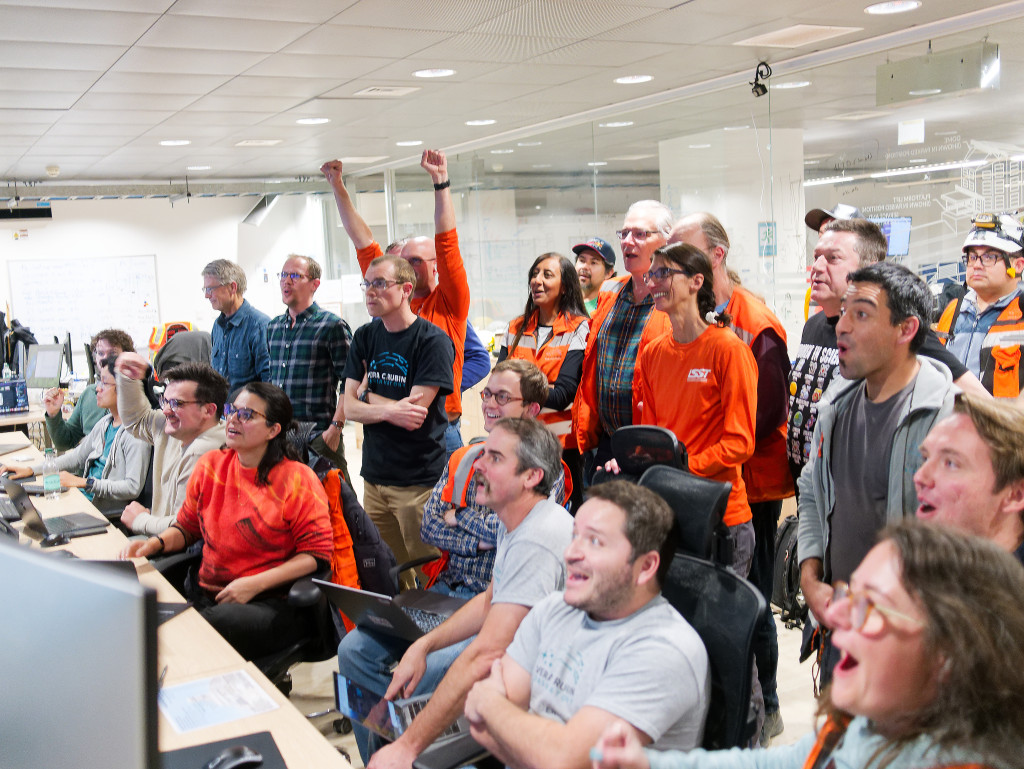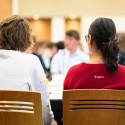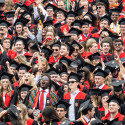UW–Madison physicists play key role in international observatory

Rubin Observatory scientists, including UW–Madison physics professor Keith Bechtol (in black t-shirt) react as they view some of the first images produced by the observatory’s camera — the largest digital camera in the world. Photo: Wil O’Mullane | Rubin Observatory
The first images of the greatest cosmic movie ever made will be released by the Vera C. Rubin Observatory on June 23, and one of the “directors” is University of Wisconsin–Madison physics professor Keith Bechtol.
It’s a story over a decade in the making for Bechtol, who currently serves in a leadership role as the observatory’s System Verification and Validation Scientist and has been part of the international collaboration since 2016. He and his UW–Madison research group have been key players on a team of thousands of people bringing the observatory to the main stage, and now its state-of-the-art telescope has started taking its first images of the night sky.
Watch This: The UW–Madison physics department is hosting a “First Look” party to view the first images collected from the Vera C. Rubin Observatory at 10 a.m. on Monday, June 23, in 2241 Chamberlin Hall, 1150 University Ave. Free and open to the public, the party will include a livestream of the first released images followed by a panel Q&A with Bechtol and other UW–Madison researchers who will use data collected by the observatory.
“Rubin Observatory is a confluence of technology that allows us to map the universe faster than we’ve ever been able to before,” Bechtol says. “It will catalog more stars, galaxies, and Solar System objects during the first year of science operations than all previous telescopes combined. We will chronicle how the universe changes over time.”
Space-based telescopes like Hubble and James Webb typically focus on one spot for a prolonged time. In contrast, the ground-based Rubin Observatory, positioned on a mountaintop in Chile, will quickly scan the sky, taking an image with its 3.2-billion-pixel camera every 40 seconds and collecting 20 terabytes of data each night. The observatory will run what astronomers are calling the “Legacy Survey of Space and Time,” capturing the entire southern hemisphere sky every three nights over its anticipated 10-year run.

Keith Bechtol, a UW–Madison physics professor, visits the Vera C. Rubin Observatory in Chile in the spring of 2025 to support the observatory’s commissioning. Pictured behind him is the Simonyi Survey Telescope. Photo: Keith Bechtol
In his role, Bechtol is one of five technical group leaders who have been organizing the observatory’s commissioning effort — the building, implementation, and testing that happens on the way to a fully operating observatory.
Bechtol oversees the science deliverables of the project.
“I gather the evidence to show that all components of Rubin Observatory are working together to produce the most detailed time-lapse view of the cosmos ever made,” Bechtol says. “I’ve been responsible for anticipating things that could go wrong and helping to address those challenges, designing observation plans, rehearsing observatory operations, and implementing tests of increasing sophistication as we built the observatory. It’s been many years of preparation to get to this point.”
Rubin is also changing the way scientists conduct astrophysics research. With many facilities before Rubin, astronomers would have to submit proposals about the type of data they wanted collected and where to aim the telescope. Many projects simply could not be completed.
“The new model is that you map the entire sky and then provide broad access,” Bechtol says. “Scientists around the world can log onto our cloud database, query for the subset of data they’re interested in, and do their analysis on the same platform. Rubin is breaking down barriers to accessing world-class astronomical data.”

Members of the UW–Madison research group who worked on the commissioning of the Rubin Observatory visit the SLAC National Accelerator Laboratory in California, where the camera for the observatory’s telescope was assembled. Pictured from left to right: Peter Ferguson, Keith Bechtol, Miranda Gorsuch and Julian Beas-Gonzalez. Photo: Keith Bechtol
Bechtol and his group will use the data to probe fundamental questions related to dark matter, dark energy, and the early universe.
“We’re using the whole universe as a laboratory to ask big, open questions about the nature of matter, energy, space, and time. What is the universe made of? How did the universe begin? How will it end?” Bechtol says. “We use measurements of strong and weak gravitational lensing and the clustering of galaxies to study dark energy, as well as so-called ultrafaint galaxies to learn about dark matter.”
Dozens of other physicists, astronomers, computer scientists, and artificial intelligence researchers at UW–Madison are expected to use this data over the coming years.
One more key contribution from Bechtol: The observatory’s name. Vera C. Rubin was a pioneering American astronomer who made the connection between galaxies and the invisible regions of dark matter that these galaxies are in. Given the connection to his work, Bechtol was one of the people who suggested naming the facility after her.
NSF–DOE Vera C. Rubin Observatory is a joint initiative of the U.S. National Science Foundation (NSF) and the U.S. Department of Energy’s Office of Science (DOE/SC). At UW–Madison, funding is provided by NSF (2206053 AST) and DOE (DE-SC0022950).




